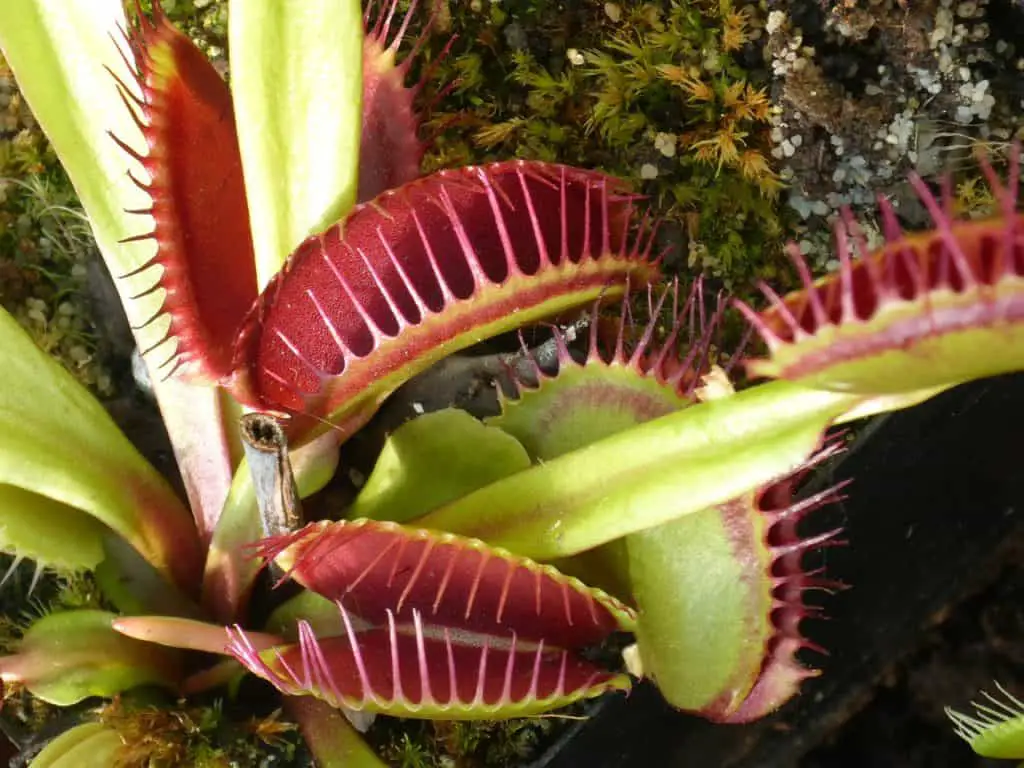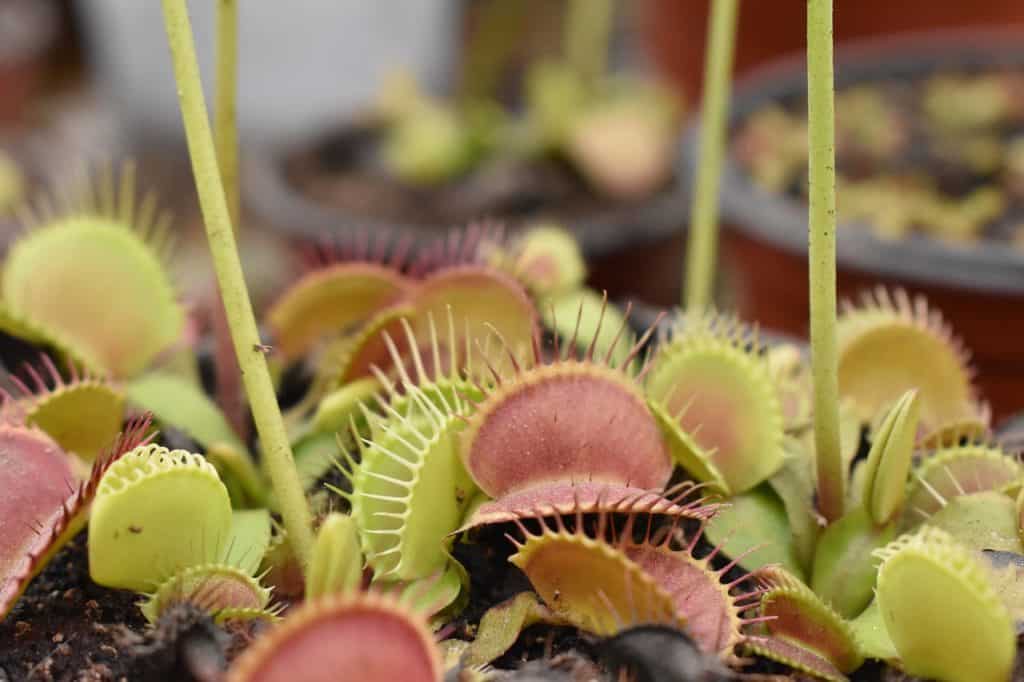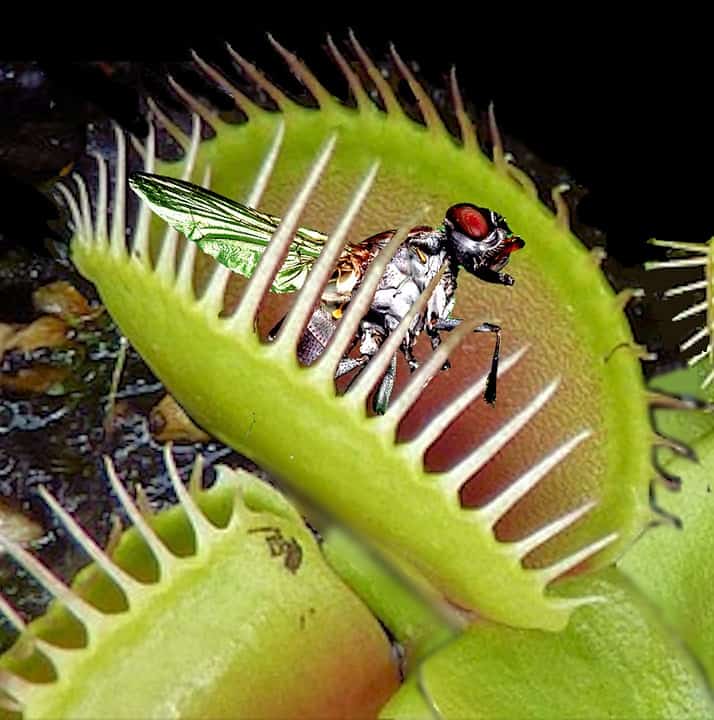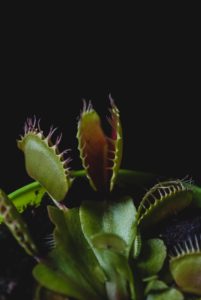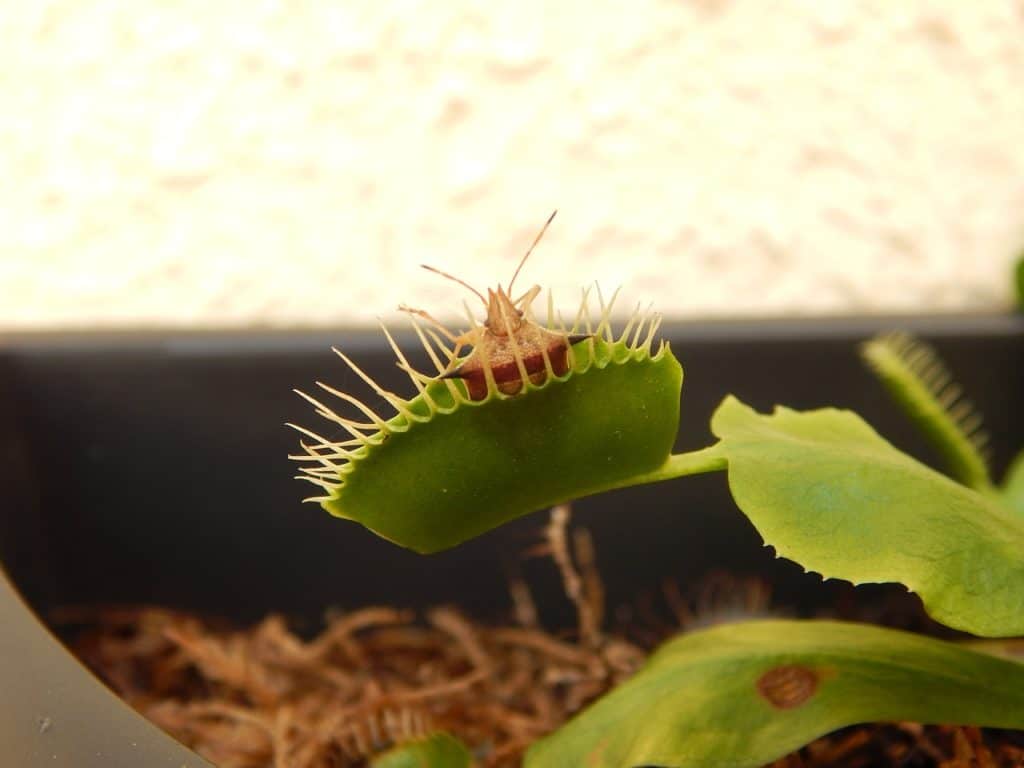Today we are going to talk about the best pots and planters for venus flytraps. It’s important that you have the right housing for your carnivorous plant. If you follow the quick answer below, you will probably be able to pick out a great pot or planter for your venus flytrap. If you want more information, definitely keep scrolling as we give some great examples and break it down for you!
Make sure to spread the word below if you find this article helpful or interesting! Pinning, liking, sharing this info helps me out so much!
Pinterest
Facebook
Twitter
Reddit
Best Pots & Planters For Venus Flytraps Quick Guide
To find the best pot or planter for a venus flytrap make it’s made out of plastic, resin or a fully glazed clay pot. Avoid terra cotta or un-glazed pots. The porous materials can cause your substrate to dry quickly by absorbing the water. They can also leach minerals that are harmful to your venus flytrap into the substrate. Make sure your pot or planter has good drainage in the bottom as venus flytraps need good water flow. Try to get a pot or planter that is at least 5-10 inches deep as Venus flytrap roots like to have room to grow. The width of the pot is not as important, just make sure it allows room for growth.
The pots below are a couple examples of planters that meet all the criteria. They are functional but also stylish, which can be a little tricky to find. Check them out and see if there is anything you like! I’ll make more suggestions below, but these are some of my favorites!
I double checked, the first planter below is great for indoors and outdoors. It’s glazed on the outside and inside, which means it won’t leach minerals into your substrate and won’t be porous and dry your soil out.
No products found.
- UNIQUE MARBLE DESIGN - This attractive marble pattern flower pot (8.6”D x 6.7”H) is the ideal...
- RAISED DRAINAGE HOLE - This planter comes with 4 pre-drilled, built-in drainage holes that create a...
- LIGHTWEIGHT MATERIALS - Made from durable recycled plastic and natural stone powder, the planter is...
- WEATHER RESISTANT - Allow you to enjoy this plant pot for outdoor plants in all types of weather....
- 100% SATISFACTION GUARANTEED - We want you to love your purchase, therefore we strive to satisfy...
Last update on 2024-05-12 / Affiliate links / Images from Amazon Product Advertising API
Table of Contents
Best Pots & Planters For Venus Flytraps
Now that you have been given the quick and simple answer, lets dig in a little more. I’m going to give you a checklist of sorts for things to look for when picking out a growing pot for a venus flytrap. When selecting a planter, there are a few things you will want to take into consideration.
It’s important to know what you are looking for as venus flytraps can be a little more demanding than a typical houseplant. There may be some considerations you need to think about that you wouldn’t normally with a houseplant.
I’m going to give you a quick checklist below, then I’m going to give you some suggestions on cool venus flytrap pots and planters I have found. Some will be purely for functionality while others will be for style. You can can have both if you find the right pot or planter!
Venus Flytraps Pots & Planters Checklist
Let’s go over some of the most important things to consider when looking at pots and planters for venus flytraps. There are a few different things that are really important when deciding which planter you want. I’m going to go over all the things to consider below to help you make the best choice for your venus flytrap pots.
Buy Carnivorous Plants Online!
Materials
The material of your pot or planter for a venus flytrap is probable the most important factor when looking at which are best. I’ll talk a little bit about the most popular planter choices and go over why you should or should not choose this material.
Fiberglass/Resin
This is probably your best choice. If you can find a nice fiberglass or resin fiberglass planter this is probably the top choice for venus flytraps. They will help keep your flytrap well insulated during dormancy but also won’t leach any minerals into your substrate. They are affordable and durable in both indoors and outdoors. Almost all my planters are either a plastic or resin/fiberglass resin.
The nice thing about resin is that they make some really stylish planters made out of resin, like the examples below.
Click Here To See Price & Photos of The Planter Below On Amazon

The resin planter above is always a favorite. I’m such a sucker for anything in a whiskey barrel. It’s a nice aesthetic but also will be a great functional pot for your venus flytrap.
Click Here To See Price & Photos of The Planter Below On Amazon

I really like this set of 3 wicker style resin planters. The great thing about this set is that you will have the planters ready to go as your venus flytraps grow. As they grow and multiply instead of looking for a new pot, you just replant them in the next size up. This set of 3 is a perfect mix of nice looking planters along with the well insulated strong resin.
Click Here For A Large Selection Of Resin Planters On Amazon!
Plastic
Plastic is probably the most functional and least expensive option. The biggest growers typically like to keep it simple and just keep their plants in simple plastic pots. If you don’t care much for looks and just want something simple and easy then plastic is the way to go.
Do keep in mind, if you live in an area that has a more harsh winter, the thin plastic pots may not give your venus flytrap the insulation it needs in winter time. You may need to work a little harder to keep your plant safe if it’s in a plastic planter. If you are in a warmer climate without a harsh winter plastic just might be the best option for you. I’ll share some of my favorite plastic planters below.
Click Here To See Price & Photos of The Pot Below On Amazon

The plastic pot above is actually quite nice looking. It’s just a thin plastic and wont insulate as good as resin but you may not need insulation! If I was going to get a cheaper plastic pot that I could show off to my friends and family, I’d get a pot like the one above!
Click Here To See Price & Photos of The Pot Below On Amazon

The plastic planter above is the king of functionality. I do like the grooves on the plastic as it gives it a little bit of character rather than the just normal smooth plastic. You can get a 12 pack of these for around $20, so the price is right. These also come with the tray!
Click Here To See Price & Photos of The Pot Below On Amazon
No products found.
Maybe you need a little color in your life? These are wonderful looking 6 inch plastic pots for your venus flytrap. They come with plugs you can put in the drainage holes. They look really nice, they really don’t even look plastic. They have more of a ceramic look but with the functionality of plastic!
Click Here For A Large Selection Of Plastic Pots And Planters On Amazon
Ceramic
When you are looking at ceramic pots there are two different choices. You have fully glazed or un-glazed ceramic pots. You really need to avoid any kind of un-glazed ceramic pots. The porous material that ceramic pots are made out of can actually sap the moisture from the substrate. You really don’t want your pot or planter absorbing water from the soil.
The other problem with un-glazed ceramic pots is they can leach minerals into the substrate. They are commonly full of sodium and if that sodium leaches into the soil it can be fatal for your venus flytrap or carnivorous plant. These plants need a substrate that is devoid of any minerals. Leaching can be really bad for your venus flytrap.
If you want to go with a ceramic pot I don’t blame you. They can be some of the most aesthetically pleasing. They also have some really interesting and neat ceramic pots. Just make sure if you go ceramic that the pot or planter is fully glazed. The glaze on the inside ensures that no leaching will occur.
I went ahead to did some research for you and found a few different examples of really nice fully glazed ceramic pots below for your venus flytraps!
Click Here To See Price & Photos of The Ceramic Pot Below On Amazon

These ceramic pots are fully glazed and absolutely beautiful. They are simple but look quite nice. The seller hand makes these ceramic pots and would look wonderful with a venus flytrap. I might actually be getting some of these for my next project!
Click Here To See Price & Photos of The Ceramic Pot Below On Amazon
No products found.
This ceramic pot will be a show stopper with venus flytraps planted inside of it. This will be one that really grabs some attention. The hand made ceramic glazed pot along with the wood stand are just beautiful. If you really want the pot thats going to get the attention from friends and family then this should be your go to.
Imagine busting this bad boy out and showing everyone your venus flytrap devouring a fly. Prepare for some oohs and ahhs for sure! It is a little pricier but definitely worth it, check out the price by clicking the link above!
There are so many really cool ceramic pots to choose from. Just make sure they are fully glazed, check out the selection below!
Click Here For A Large Selection Of Glazed Ceramic Pots!
Terracotta
Terracotta pots and planters are extremely popular. They are not a good choice for carnivorous plants or venus flytraps. I would avoid them at all costs. They are extremely porous and will drink in a lot of the water. They also are terrible at leaching minerals into the substrate. If you can avoid terracotta, I would do so at all costs for a venus flytrap.
Clay Pots
Virtually the exact same for clay pots as for terracotta. Unless the clay pots are glazed, I would avoid them entirely for the same reasons were avoiding the terracotta or un-glazed ceramic pots.
Venus Flytrap Info Via Carnivorousplantshub.com
Drainage
It’s extremely important that your pot or planter for a venus flytrap has good drainage holes in the bottom. The water needs to have a place to escape to prevent root rot. At the same time, you need to make sure to have holes in the bottom if you are watering with the tray method.
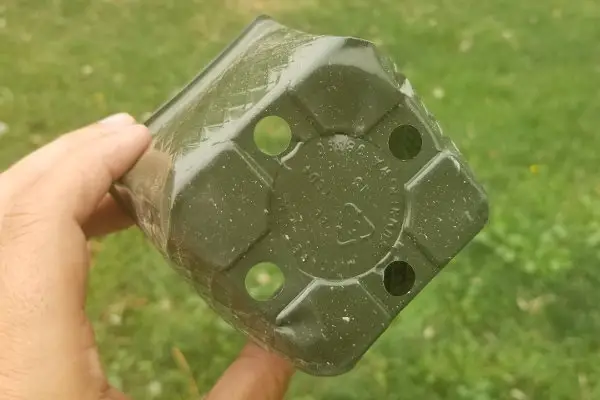
Keep in mind, if you find the perfect planter that doesn’t have holes in the bottom you can always easily drill your own holes with a power drill. It’s pretty straight forward and simple. Plastic or resin is much easier to drill the holes than ceramic. With ceramic pots you do have a higher chance of breaking the pot when drilling a hole. It’s usually easiest just to find a pot or planter with pre drilled holes.
It’s important to note the pots and planters I showed you above all had pre drilled holes!
Color
Even the color can be important depending on what are you are in. If you are in a hot area and leave your venus flytraps in full sun it might be a good idea to aim for a light color. I have seen people that have fried their plant by leaving it in a black planter in full hot sun.
If you live in an area that has less harsh summers and temps rarely go above 100, then you probably don’t have to worry about it as much. California saw many days this summer with temps well above 100. A venus flytrap in a black planter could have easily become way too hot in those conditions.
Try to stick to white or even just a lighter grey color. Other colors work well too as long as they aren’t dark.
Size
I would recommend that you at least get a pot or planter that is at least 5 inches deep. The width doesn’t matter as much as you just want to make sure that you leave enough room for the venus flytrap to grow a little bit.
You want to go at least 5 inches deep since venus flytrap roots like to grow straight down. They don’t usually grow in circles or clusters, they go straight down. If you ever buy one from a grower you will often see the roots shooting out through the bottom of those little 2.5 or 3 inch plastic pots. That’s a tell that they need a deeper pot.

It’s tempting to get a smaller pot due to the amount of really cool ceramic pots that have been made for all the succulent lovers out there. Succulents have much smaller root systems and don’t need that depth. I know it’s tempting but avoid the cute owl planter unless it’s at least 5 inches deep.
Get What You Like
Most importantly guys, get the venus flytrap pot or planter that you really like. I suggest looking around and don’t get too stuck up on price. It’s very important that you love looking at your plant. Venus flytraps are beautiful and will make any old planter look amazing, but get the planter you love. Find one that speaks to you!
There are so many options out there you can really find a good planter for your venus flytrap that matches your personality. Have fun with it! Buying your planter should be fun and exciting. When you get done planting your venus flytraps in your new pot or planter you should be ready to take a photo and share it with the world! Check out my most recent replant below, I love it!
Conclusion
I really hope you learned everything you needed today so you can pick out the perfect venus flytrap pot. Having the right planter is so very important and will help you fall in love with these plants!
If you thought this article was helpful, it would mean so much to me if you shared it on your favorite social media platform. Whether it’s Pinterest, Instagram or Facebook, it helps me out a lot!
I have a dream to open my own carnivorous plant nursery some day and I’m using this website as a platform to learn and interact with the community. Thank you for your support, it means more to me than you could ever know!
Also, make sure to check out our YouTube channel, it has all kinds of fun venus flytrap and other carnivorous plant content. Your subscription or video like helps me out a lot! Check out one of our videos below!
Also, check out the carnivorous plant society below if you are passionate about learning more or conservation for carnivorous plants!
https://www.carnivorousplants.org/
https://youtu.be/j6UkfpWpe7U




